Portable icons, due to their distinctive construction, are susceptible to degradation from various factors related to exposure, handling, storage, and other conditions. This article provides a concise examination of the “natural causes” and “external factors” that contribute to their deterioration, aiming to enhance the understanding of these causes and promote better preservation practices.
I. Natural Causes
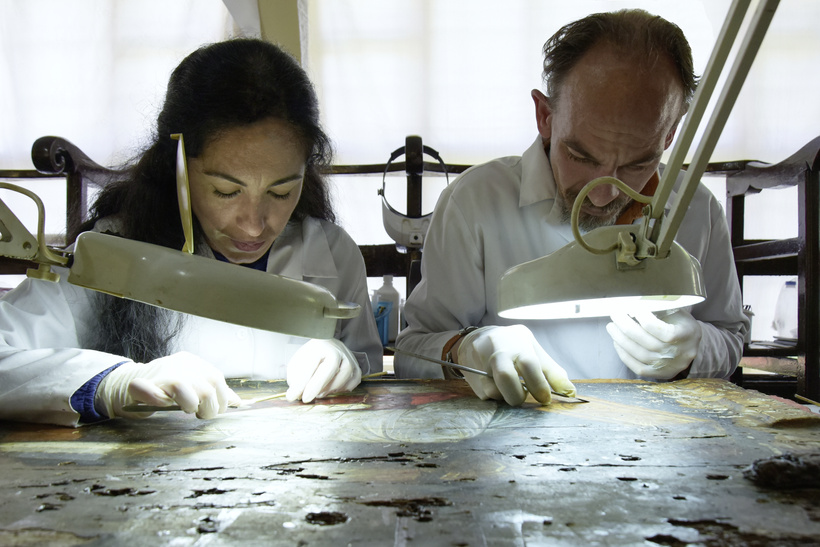
©VENIS STUDIOS
Environmental Factors
Environmental parameters significantly influence the materials used in the construction of icons, both individually and in combination. For example, when relative humidity decreases, the painted surface of an icon loses moisture more quickly than its wooden substrate. This disparity causes the wood to warp, while the paint layer, unable to follow the wood’s movement, develops cracks.
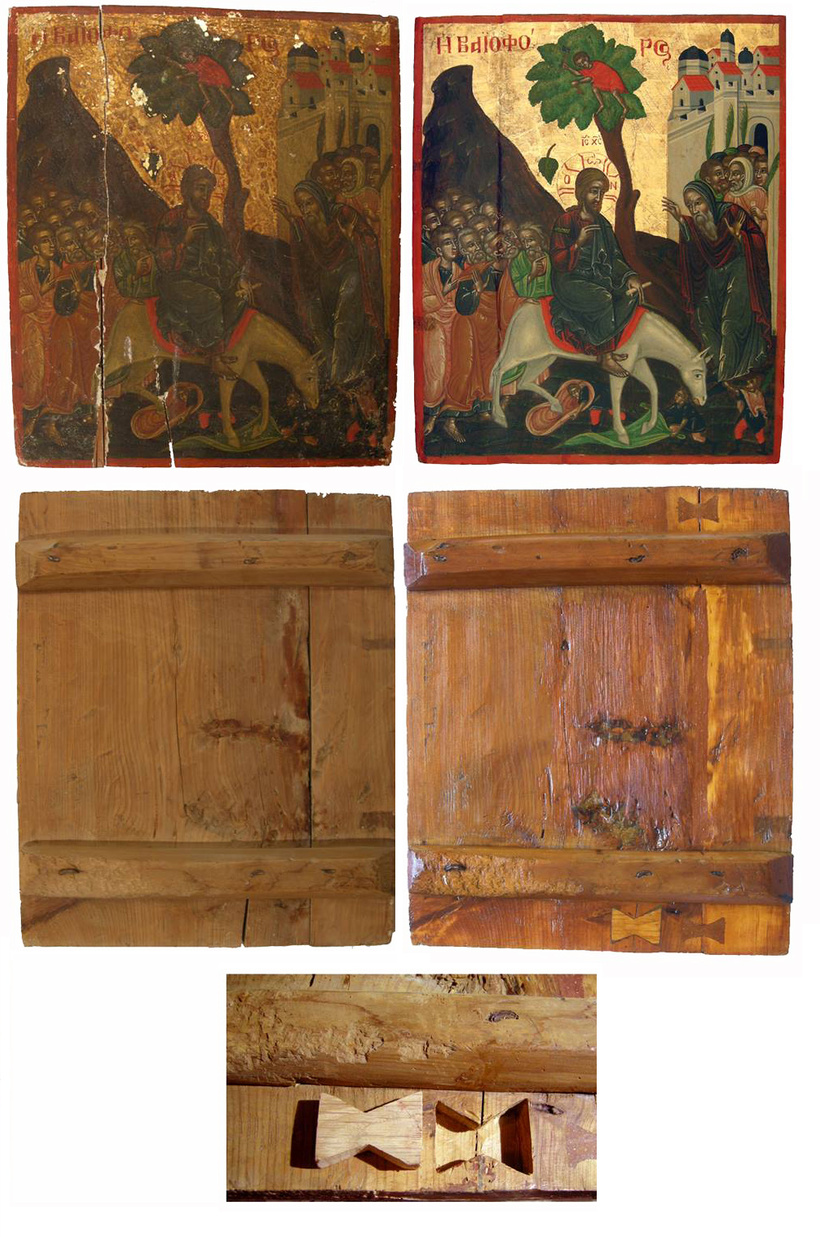
©VENIS STUDIOS
Mechanical Deterioration
Wood, an organic and hygroscopic material, undergoes deterioration starting from the moment it is cut from the tree, as it loses a substantial amount of moisture. Although it maintains some moisture content, it releases this gradually to balance with the ambient humidity. This gradual change causes the wood to move in a direction opposite to its original composition, leading to warping. The extent of warping is influenced by how the wood is cut; a wood cut parallel to the surface of the trunk and farther from the central axis warps more than a woodcut close to the trunk’s diameter. The rate of warping also depends on the type of wood, its porosity, the distribution of pores, and variations in relative humidity. Initially, the wood contains a high moisture content, and it suffers more substantial deterioration as this moisture evaporates. Hardwood species such as walnuts and beech undergo significant mechanical alterations but are more resistant to impacts and biological agents like insects and fungi. The quality of the wood is crucial for its future behaviour wood with knots experiences local stresses at these points, leading to crack formation. Many icons feature wooden battens, known as “tresa” or crosspieces, on the back of the wooden panel. These battens were either nailed or slid into specially carved grooves in the wood. Their primary purpose is to stabilize the wood and prevent warping. However, cracks can still develop in icons with “tresa” as the forces from the wood’s natural movement tend to accumulate in these areas, leading to localized stress and cracking.
Fungi
Fungi manifest in various forms and act on wood with very high moisture content, especially in more hygroscopic (soft) woods. The commonly used woods by icon painters are quite resistant to fungal activity. However, more recent icons made from poorer-quality wood are more susceptible to fungi and microorganisms. Fungi can act superficially, affecting the wood’s colour, texture, and mechanical strength.
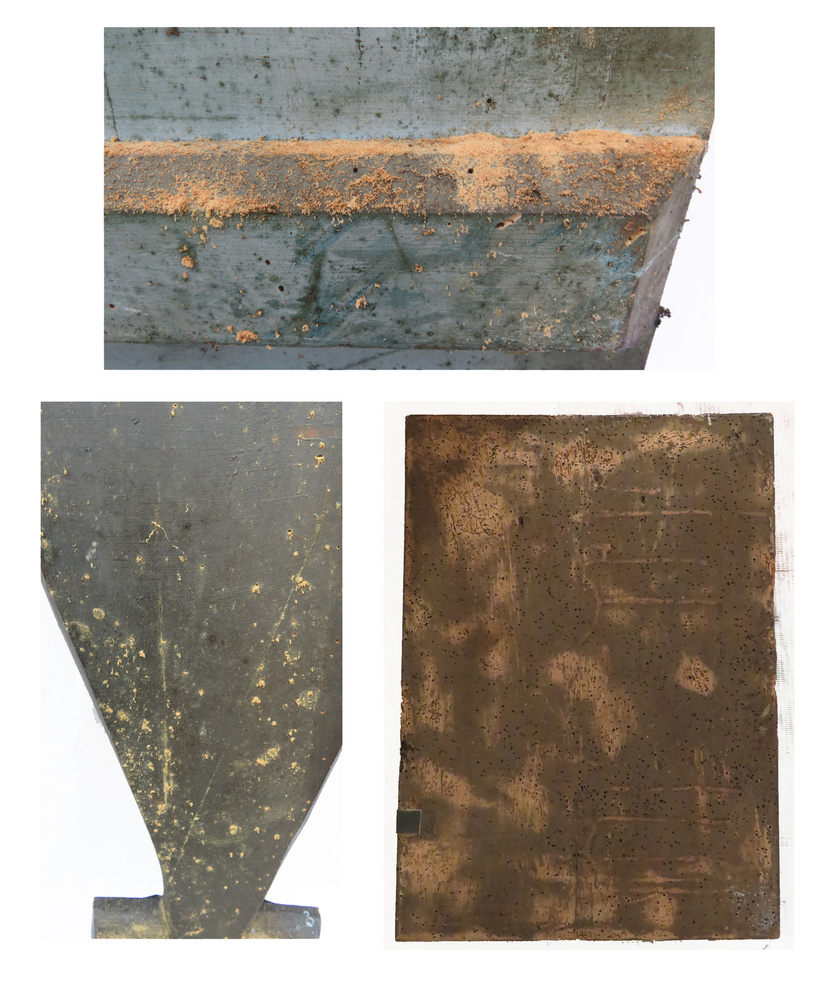
©VENIS STUDIOS
Wood-Boring Insects
Wood-boring insects go through four life stages: egg, larva, pupa, and adult. They feed on wood during three of these stages. The insect lays its eggs on the wood, where they hatch, and the larvae consume the wood’s nutrients, leaving behind dust inside the wood. These insects create tunnels parallel to the wood grain, where the wood is softer. Like fungi, they thrive in high humidity and mainly infest hygroscopic (soft) woods, which tend to retain internal moisture, facilitating egg incubation and food availability.
Photochemical Deterioration
Light affects the surface of the wood, altering its appearance rather than its mechanical strength by changing its colour. This happens because the tannins in the wood react with atmospheric elements. Some wood species bleach under light exposure, like walnut and mahogany, while others, like oak, rosewood, and mulberry, may yellow slightly. Others, like boxwood, darken.

©VENIS STUDIOS
Preparation Layer Deterioration
Cracking and delamination of the preparation layer often stem from similar deterioration in the underlying wood. As the wood moves, the preparation layer cannot follow these movements, leading to cracks or detachment. The preparation layer also deteriorates due to environmental fluctuations: it absorbs moisture, causing it to swell and become more prone to microbial attack, and shrinks in low relative humidity, resulting in cracking.

©VENIS STUDIOS
Paint Layer Deterioration
Colours degrade under the influence of light and atmospheric oxygen. In portable icons, the colours are protected by a varnish layer. Egg tempera is excellent at retaining pigment particles, especially in mineral pigments, which remain unchanged. The gold leaf itself does not deteriorate, but its underlying preparation (Gesso) can. Glazes and gold decorations are more unstable layers due to their thinner application.
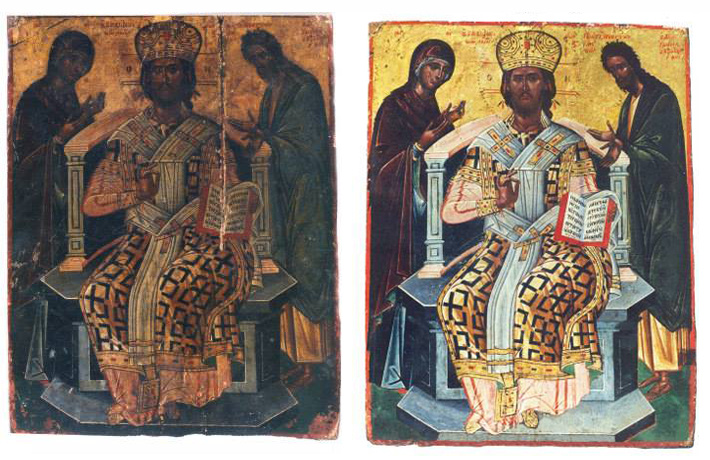
©VENIS STUDIOS
Varnish Deterioration
The varnish acts as a protective layer covering the paint and directly interacts with light, oxygen, and atmospheric pollutants, leading to significant alterations. Natural resins, being polymeric substances, oxidize easily, changing in appearance (e.g., yellowing). Varnishes with low melting points, such as colophony, soften at high temperatures, attracting dust and pollutants. Over time, varnishes tend to harden and shrink, forming surface cracks. Some varnishes, like shellac, are sensitive to moisture, which changes their colour. Damar resin is considered the best among natural resins, yet it too yellows significantly with age.
II. External Factors
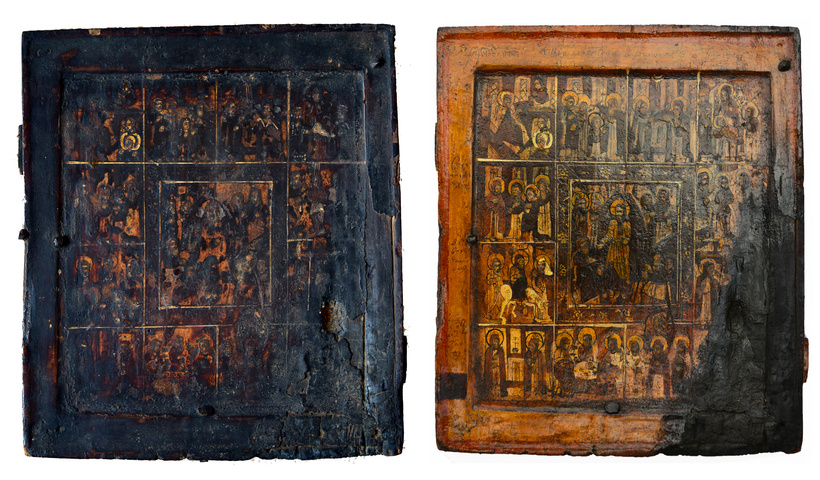
©VENIS STUDIOS
Fire
Fire can destroy the wooden structure of an icon and irreversibly alter its colours and varnishes. The extremely high temperatures generated during a fire cause irreversible and total damage to icons, rendering them beyond repair.
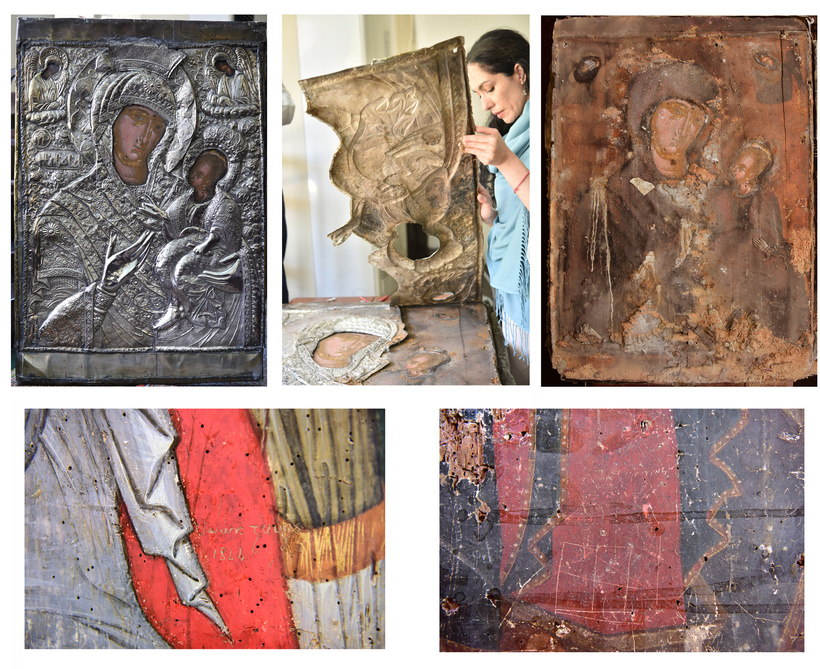
©VENIS STUDIOS
Human Factors
Vandalism, including scratches and inscriptions, is a frequent issue with portable icons. Names, dedications, and other markings are often carved into the surface. Icons also suffer mechanical damage from negligence, such as drops, or from objects like offerings (tamata) that are affixed to them. A common but destructive practice is the application of oil-based paints to the back of icons, which traps moisture within the wood and promotes the growth of wood-boring insects. The attachment of metal coverings, known as “offerings” or “pamphylla,” using nails not only causes additional mechanical wear where the metal contacts the surface of the icon but also facilitates the accumulation of dust and the growth of microorganisms underneath the offerings. This process not only damages the painting but also exacerbates the deterioration of the wood.
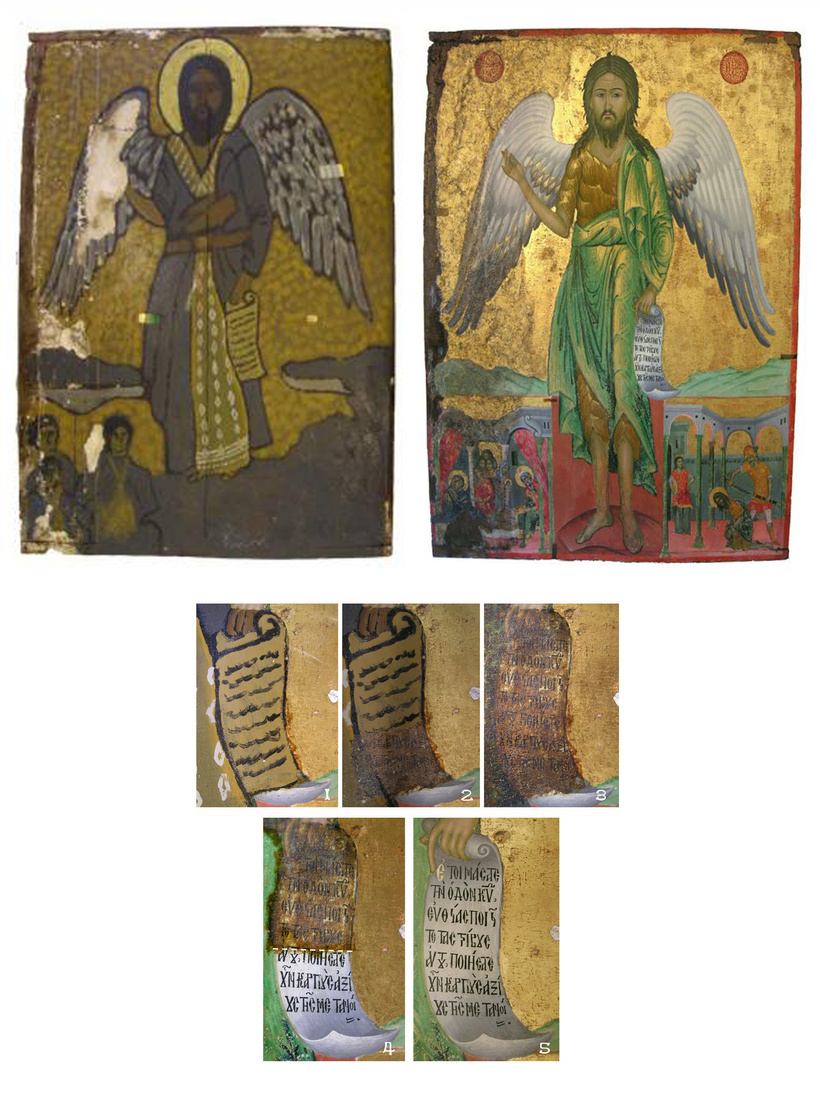
©VENIS STUDIOS
Later Interventions and Overpainting
Previous restoration attempts often involved the use of inappropriate materials, including unsuitable fillers, paints, or bronze powder, as well as cleaning with harsh solvents and methods by unskilled and unprofessional individuals and amateurs. These practices have resulted in significant damage to the icons. Additionally, older icons have frequently undergone repainting, leading to the presence of multiple layers of paint. In some cases, due to damage caused by aggressive cleaning or other factors, icons have been partially or entirely overpainted. This misguided practice, aimed at concealing damage, allows the new painter to impose their interpretation on the original work, often compromising the icon’s historical and artistic integrity.
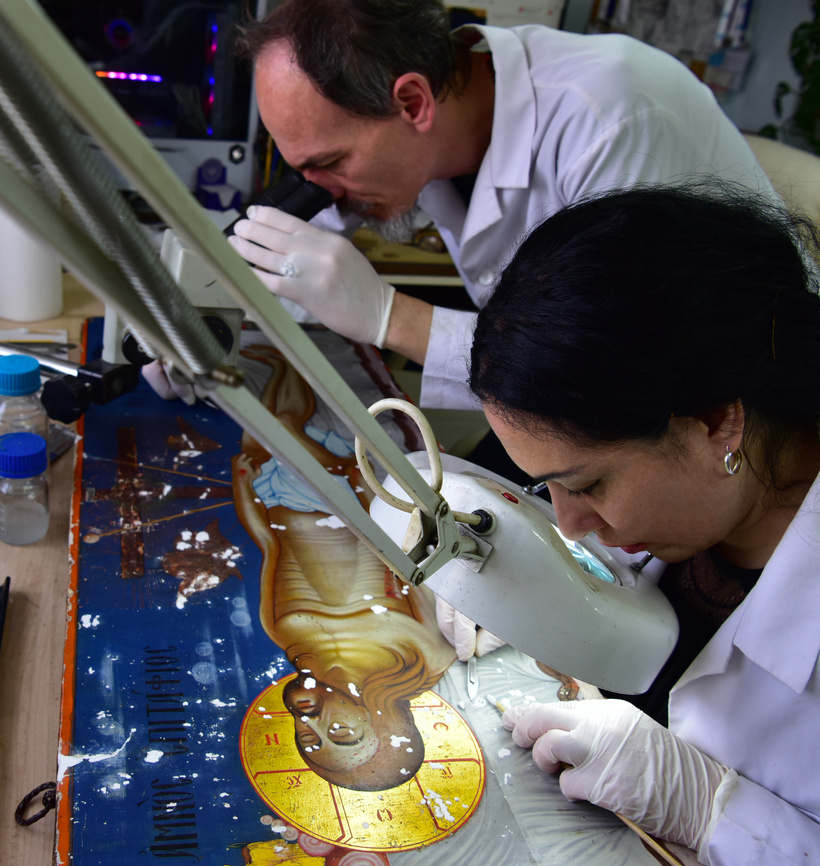
©VENIS STUDIOS
In conclusion, the intricate construction of portable icons renders them vulnerable to a myriad of deteriorative forces stemming from environmental conditions, mechanical stresses, biological agents, and photochemical effects. This comprehensive examination has underscored the critical influence of natural causes such as environmental parameters and mechanical properties of wood, as well as the detrimental impact of external factors like fungi, wood-boring insects, and photochemical reactions on icon preservation. Each factor contributes uniquely to the degradation process, emphasizing the complexity of conserving these artefacts.
Understanding these underlying causes is pivotal for developing effective preservation strategies. By acknowledging the interplay between natural and external factors, conservation efforts can be tailored to mitigate specific risks and prolong the longevity of portable icons. Emphasizing the need for meticulous handling, controlled storage environments, and judicious restoration practices becomes imperative in safeguarding the artistic and historical integrity of these cultural treasures for future generations.
In essence, this examination serves to enhance awareness and inform preservation practices, ensuring that portable icons continue to convey their spiritual and artistic significance with enduring clarity and reverence in the face of evolving challenges.
I want to learn more:
by Venizelos G. Gavrilakis
Edited Athina Gkouma
About the author:
Venizelos G. Gavrilakis, a renowned expert in the art conservation and restoration of Byzantine and post-Byzantine icons, historical oil paintings, and Ottoman-era artwork, has been working as a senior expert conservator and restorer since 1994. He has worked with various institutions and has been involved in international conservation meetings and conferences. Gavrilakis is the president of the art conservation and restoration company VENIS STUDIOS, based in Istanbul, Turkey, and has collaborated with galleries, antique dealers, and private collectors.
-
Articles: World Art News articles
Our related articles

